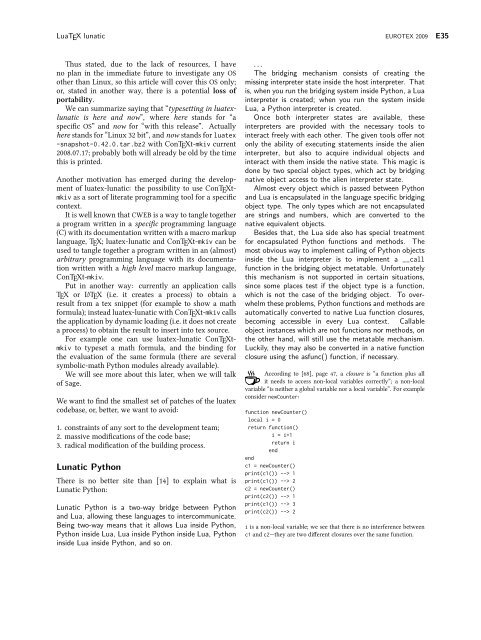Complete issue 30:3 as one pdf - TUG
Complete issue 30:3 as one pdf - TUG
Complete issue 30:3 as one pdf - TUG
Create successful ePaper yourself
Turn your PDF publications into a flip-book with our unique Google optimized e-Paper software.
LuaTEX lunatic EUROTEX 2009 E35<br />
Thus stated, due to the lack of resources, I have<br />
no plan in the immediate future to investigate any OS<br />
other than Linux, so this article will cover this OS only;<br />
or, stated in another way, there is a potential loss of<br />
portability.<br />
Wecansummarizesayingthat“typesettinginluatexlunatic<br />
is here and now”, where here stands for “a<br />
specic OS” and now for “with this rele<strong>as</strong>e”. Actually<br />
herestandsfor“Linux32bit”,andnowstandsforluatex<br />
-snapshot-0.42.0.tar.bz2 with ConTEXt-mkiv current<br />
2008.07.17;probablybothwillalreadybeoldbythetime<br />
thisisprinted.<br />
Another motivation h<strong>as</strong> emerged during the development<br />
of luatex-lunatic: the possibility to use ConTEXtmkiv<br />
<strong>as</strong> a sort of literate programming tool for a specic<br />
context.<br />
ItiswellknownthatCWEBisawaytotangletogether<br />
a program written in a specic programming language<br />
(C)withitsdocumentationwrittenwithamacromarkup<br />
language, TEX; luatex-lunatic and ConTEXt-mkiv can be<br />
usedtotangletogetheraprogramwritteninan(almost)<br />
arbitrary programming language with its documentation<br />
written with a high level macro markup language,<br />
ConTEXt-mkiv.<br />
Put in another way: currently an application calls<br />
TEX or L ATEX (i.e. it creates a process) to obtain a<br />
result from a tex snippet (for example to show a math<br />
formula);insteadluatex-lunaticwithConTEXt-mkivcalls<br />
theapplicationbydynamicloading(i.e.itdoesnotcreate<br />
aprocess) to obtainthe resultto insertintotex source.<br />
For example <strong>one</strong> can use luatex-lunatic ConTEXtmkiv<br />
to typeset a math formula, and the binding for<br />
the evaluation of the same formula (there are several<br />
symbolic-mathPythonmodulesalready available).<br />
We will see more about this later, when we will talk<br />
of Sage.<br />
We want to nd the smallest set of patches of the luatex<br />
codeb<strong>as</strong>e, or, better, we want to avoid:<br />
1. constraintsofanysort to the developmentteam;<br />
2. m<strong>as</strong>sive modicationsofthe code b<strong>as</strong>e;<br />
3. radical modication ofthe buildingprocess.<br />
Lunatic Python<br />
There is no better site than [14] to explain what is<br />
LunaticPython:<br />
Lunatic Python is a two-way bridge between Python<br />
and Lua, allowing these languages to intercommunicate.<br />
Being two-way means that it allows Lua inside Python,<br />
Python inside Lua, Lua inside Python inside Lua, Python<br />
inside Lua inside Python, and so on.<br />
. . .<br />
The bridging mechanism consists of creating the<br />
missing interpreter state inside the host interpreter. That<br />
is, when you run the bridging system inside Python, a Lua<br />
interpreter is created; when you run the system inside<br />
Lua, a Python interpreter is created.<br />
Once both interpreter states are available, these<br />
interpreters are provided with the necessary tools to<br />
interact freely with each other. The given tools offer not<br />
only the ability of executing statements inside the alien<br />
interpreter, but also to acquire individual objects and<br />
interact with them inside the native state. This magic is<br />
d<strong>one</strong> by two special object types, which act by bridging<br />
native object access to the alien interpreter state.<br />
Almost every object which is p<strong>as</strong>sed between Python<br />
and Lua is encapsulated in the language specific bridging<br />
object type. The only types which are not encapsulated<br />
are strings and numbers, which are converted to the<br />
native equivalent objects.<br />
Besides that, the Lua side also h<strong>as</strong> special treatment<br />
for encapsulated Python functions and methods. The<br />
most obvious way to implement calling of Python objects<br />
inside the Lua interpreter is to implement a __call<br />
function in the bridging object metatable. Unfortunately<br />
this mechanism is not supported in certain situations,<br />
since some places test if the object type is a function,<br />
which is not the c<strong>as</strong>e of the bridging object. To overwhelm<br />
these problems, Python functions and methods are<br />
automatically converted to native Lua function closures,<br />
becoming accessible in every Lua context. Callable<br />
object instances which are not functions nor methods, on<br />
the other hand, will still use the metatable mechanism.<br />
Luckily, they may also be converted in a native function<br />
closure using the <strong>as</strong>func() function, if necessary.<br />
According to [68], page 47, a closure is “a function plus all<br />
it needs to access non-local variables correctly”; a non-local<br />
variable“isneitheraglobalvariablenoralocalvariable”. Forexample<br />
consider newCounter:<br />
function newCounter()<br />
local i = 0<br />
return function()<br />
i = i+1<br />
return i<br />
end<br />
end<br />
c1 = newCounter()<br />
print(c1()) --> 1<br />
print(c1()) --> 2<br />
c2 = newCounter()<br />
print(c2()) --> 1<br />
print(c1()) --> 3<br />
print(c2()) --> 2<br />
i is a non-local variable; we see that there is no interference between<br />
c1 and c2—theyaretwodierentclosures overthesame function.

















